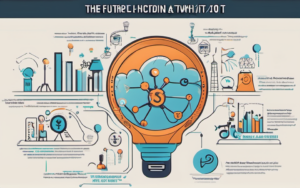In today’s rapidly evolving technological landscape, businesses are constantly seeking ways to stay ahead of the curve and drive innovation. One key factor that can make or break an organization’s success is its Innovation Culture. This culture is built on a foundation of curiosity, experimentation, and a willingness to embrace change. This is where emerging technologies play a crucial role, providing organizations with powerful tools to foster innovation and unlock new possibilities.
Understanding the Power of Emerging Technologies
Emerging technologies like Artificial Intelligence (AI), Internet of Things (IoT), Blockchain, Cloud Computing, and Virtual and Augmented Reality (VR/AR) are transforming industries and shaping the future of work. These technologies offer unprecedented opportunities for businesses to streamline operations, enhance customer experiences, and develop innovative products and services.
Artificial Intelligence (AI)
AI is revolutionizing how businesses operate. From automating repetitive tasks to analyzing vast amounts of data and predicting future trends, AI can significantly enhance productivity and efficiency. Machine learning algorithms can analyze customer data to personalize experiences, identify patterns in market trends, and optimize business processes.
Internet of Things (IoT)
The IoT connects physical devices to the internet, enabling businesses to collect and analyze real-time data from their operations. This data can be used to optimize production processes, improve supply chain management, and develop predictive maintenance strategies. Smart sensors can monitor equipment performance, detect potential issues, and trigger automated responses, minimizing downtime and reducing costs.
Blockchain
Blockchain technology is known for its secure, transparent, and immutable nature. It can be used to create decentralized systems that track transactions and data, ensuring transparency and accountability. Businesses can leverage blockchain for secure supply chain management, secure data storage, and efficient financial transactions.
Cloud Computing
Cloud computing provides businesses with scalable and flexible computing resources, allowing them to access and manage data from anywhere in the world. This enables organizations to quickly adapt to changing business needs, reducing the need for expensive hardware investments. Cloud-based platforms also offer powerful tools for collaboration, data analysis, and application development.
Virtual and Augmented Reality (VR/AR)
VR and AR technologies are creating immersive experiences that are transforming industries like training, education, and entertainment. VR can simulate real-world environments, providing realistic training scenarios for employees and customers. AR overlays digital information onto the real world, enhancing user experiences and providing valuable insights.
Creating an Innovation-Friendly Environment
To effectively leverage emerging technologies for innovation, organizations need to cultivate a culture that embraces experimentation, risk-taking, and collaboration. This means creating an environment where employees feel empowered to share ideas, explore new possibilities, and contribute to the company’s growth.
Fostering a Growth Mindset
A growth mindset is essential for driving innovation. It encourages employees to view challenges as opportunities for learning and growth, rather than threats. Organizations can foster a growth mindset by celebrating failures as learning experiences, providing opportunities for continuous learning and development, and recognizing employees’ efforts to push boundaries.
Encouraging Experimentation and Risk-Taking
Innovation requires experimentation and risk-taking. Organizations need to create an environment where employees feel comfortable trying new things, even if they might not succeed. This can involve establishing dedicated innovation labs or teams, providing resources for experimentation, and celebrating successful experiments, even if they don’t lead to a final product.
Promoting Collaboration and Knowledge Sharing
Collaboration is crucial for innovation. Organizations need to create opportunities for employees from different departments and disciplines to work together and share ideas. This can involve cross-functional teams, knowledge-sharing platforms, and regular brainstorming sessions.
Providing Resources and Support
Organizations need to provide employees with the resources and support they need to innovate. This includes access to emerging technologies, training programs, mentorship opportunities, and access to experts. It also means providing employees with the time and space they need to focus on innovative projects.
Leveraging Emerging Technologies for Innovation
Once an innovation-friendly environment is established, organizations can leverage emerging technologies to drive growth and unlock new possibilities.
AI-Powered Automation and Optimization
AI can automate repetitive tasks, freeing up employees to focus on more strategic and creative work. AI can also analyze data to identify patterns and insights that can be used to optimize business processes, improve customer experiences, and develop new products and services.
IoT-Enabled Data Collection and Analysis
The IoT can be used to collect real-time data from a wide range of devices, providing businesses with a wealth of insights into their operations. This data can be used to improve production processes, optimize supply chain management, and develop new products and services based on customer needs.
Blockchain for Secure and Transparent Transactions
Blockchain technology can be used to create secure and transparent systems for tracking transactions and data. This can be used to improve supply chain management, ensure data security, and enhance financial transactions.
Cloud Computing for Scalability and Flexibility
Cloud computing provides businesses with the scalability and flexibility they need to grow and adapt to changing market conditions. It allows businesses to access and manage data from anywhere in the world, enabling them to quickly scale their operations and respond to customer needs.
VR/AR for Enhanced Training and Customer Experiences
VR and AR technologies can create immersive experiences that enhance training programs and customer experiences. VR can simulate real-world environments, providing realistic training scenarios for employees and customers. AR overlays digital information onto the real world, enhancing user experiences and providing valuable insights.
Overcoming Challenges and Ethical Considerations
While emerging technologies offer tremendous opportunities, they also pose challenges and ethical considerations.
Data Privacy and Security
The use of emerging technologies raises concerns about data privacy and security. Organizations need to implement robust data protection measures, ensure compliance with relevant regulations, and be transparent with customers about how their data is collected and used.
Job Displacement and Workforce Reskilling
The automation of tasks by AI and other emerging technologies raises concerns about job displacement. Organizations need to invest in workforce reskilling programs to equip employees with the skills they need to thrive in a technology-driven workplace.
Ethical Implications of AI and Automation
The development and deployment of AI and automation raise ethical considerations. Organizations need to ensure that AI systems are developed and used responsibly, avoiding bias and discrimination. They also need to be transparent about how AI is being used and its impact on decision-making.
Embracing the Future of Innovation
The future of innovation lies in embracing emerging technologies and fostering a culture that values experimentation, collaboration, and continuous learning. Organizations that embrace this approach will be well-positioned to thrive in the rapidly evolving technological landscape.
By creating an innovation-friendly environment and leveraging the power of emerging technologies, organizations can unlock new possibilities, enhance customer experiences, and drive growth. However, it is crucial to address the ethical considerations and challenges associated with these technologies to ensure their responsible and sustainable use. The key to success lies in embracing the future of innovation with a strategic mindset and a commitment to ethical principles.




